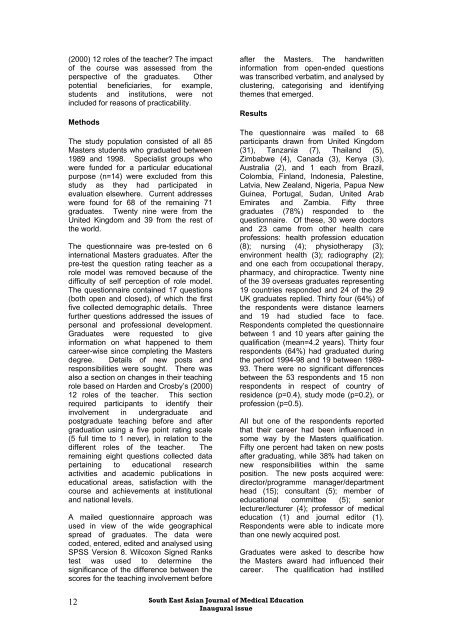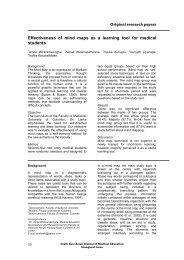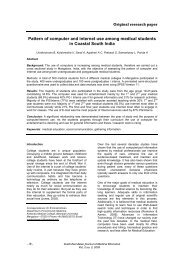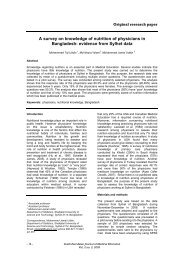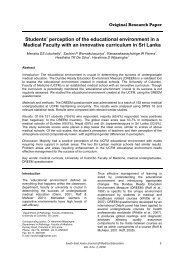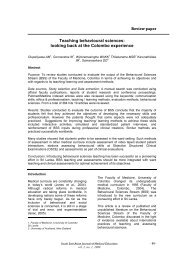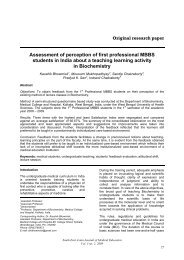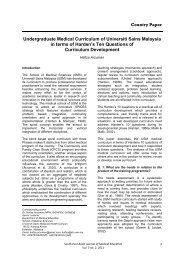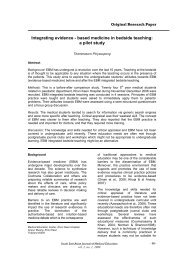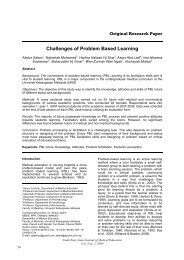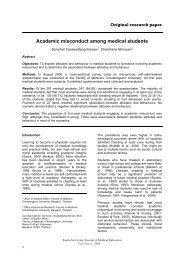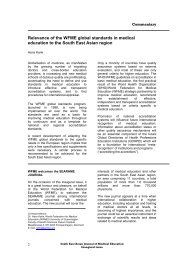Untitled - South East Asian Journal of Medical Education
Untitled - South East Asian Journal of Medical Education
Untitled - South East Asian Journal of Medical Education
Create successful ePaper yourself
Turn your PDF publications into a flip-book with our unique Google optimized e-Paper software.
(2000) 12 roles <strong>of</strong> the teacher? The impact<strong>of</strong> the course was assessed from theperspective <strong>of</strong> the graduates. Otherpotential beneficiaries, for example,students and institutions, were notincluded for reasons <strong>of</strong> practicability.MethodsThe study population consisted <strong>of</strong> all 85Masters students who graduated between1989 and 1998. Specialist groups whowere funded for a particular educationalpurpose (n=14) were excluded from thisstudy as they had participated inevaluation elsewhere. Current addresseswere found for 68 <strong>of</strong> the remaining 71graduates. Twenty nine were from theUnited Kingdom and 39 from the rest <strong>of</strong>the world.The questionnaire was pre-tested on 6international Masters graduates. After thepre-test the question rating teacher as arole model was removed because <strong>of</strong> thedifficulty <strong>of</strong> self perception <strong>of</strong> role model.The questionnaire contained 17 questions(both open and closed), <strong>of</strong> which the firstfive collected demographic details. Threefurther questions addressed the issues <strong>of</strong>personal and pr<strong>of</strong>essional development.Graduates were requested to giveinformation on what happened to themcareer-wise since completing the Mastersdegree. Details <strong>of</strong> new posts andresponsibilities were sought. There wasalso a section on changes in their teachingrole based on Harden and Crosby’s (2000)12 roles <strong>of</strong> the teacher. This sectionrequired participants to identify theirinvolvement in undergraduate andpostgraduate teaching before and aftergraduation using a five point rating scale(5 full time to 1 never), in relation to thedifferent roles <strong>of</strong> the teacher. Theremaining eight questions collected datapertaining to educational researchactivities and academic publications ineducational areas, satisfaction with thecourse and achievements at institutionaland national levels.A mailed questionnaire approach wasused in view <strong>of</strong> the wide geographicalspread <strong>of</strong> graduates. The data werecoded, entered, edited and analysed usingSPSS Version 8. Wilcoxon Signed Rankstest was used to determine thesignificance <strong>of</strong> the difference between thescores for the teaching involvement beforeafter the Masters. The handwritteninformation from open-ended questionswas transcribed verbatim, and analysed byclustering, categorising and identifyingthemes that emerged.ResultsThe questionnaire was mailed to 68participants drawn from United Kingdom(31), Tanzania (7), Thailand (5),Zimbabwe (4), Canada (3), Kenya (3),Australia (2), and 1 each from Brazil,Colombia, Finland, Indonesia, Palestine,Latvia, New Zealand, Nigeria, Papua NewGuinea, Portugal, Sudan, United ArabEmirates and Zambia. Fifty threegraduates (78%) responded to thequestionnaire. Of these, 30 were doctorsand 23 came from other health carepr<strong>of</strong>essions: health pr<strong>of</strong>ession education(8); nursing (4); physiotherapy (3);environment health (3); radiography (2);and one each from occupational therapy,pharmacy, and chiropractice. Twenty nine<strong>of</strong> the 39 overseas graduates representing19 countries responded and 24 <strong>of</strong> the 29UK graduates replied. Thirty four (64%) <strong>of</strong>the respondents were distance learnersand 19 had studied face to face.Respondents completed the questionnairebetween 1 and 10 years after gaining thequalification (mean=4.2 years). Thirty fourrespondents (64%) had graduated duringthe period 1994-98 and 19 between 1989-93. There were no significant differencesbetween the 53 respondents and 15 nonrespondents in respect <strong>of</strong> country <strong>of</strong>residence (p=0.4), study mode (p=0.2), orpr<strong>of</strong>ession (p=0.5).All but one <strong>of</strong> the respondents reportedthat their career had been influenced insome way by the Masters qualification.Fifty one percent had taken on new postsafter graduating, while 38% had taken onnew responsibilities within the sameposition. The new posts acquired were:director/programme manager/departmenthead (15); consultant (5); member <strong>of</strong>educational committee (5); seniorlecturer/lecturer (4); pr<strong>of</strong>essor <strong>of</strong> medicaleducation (1) and journal editor (1).Respondents were able to indicate morethan one newly acquired post.Graduates were asked to describe howthe Masters award had influenced theircareer. The qualification had instilled12<strong>South</strong> <strong>East</strong> <strong>Asian</strong> <strong>Journal</strong> <strong>of</strong> <strong>Medical</strong> <strong>Education</strong>Inaugural issue


